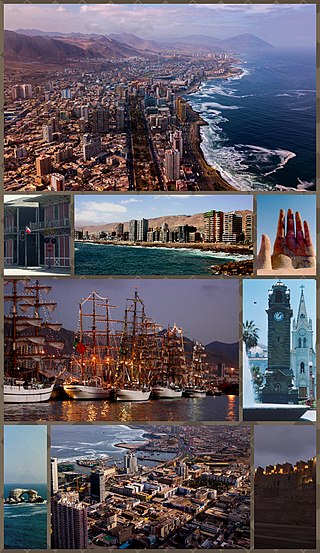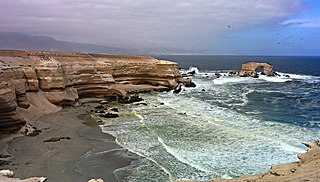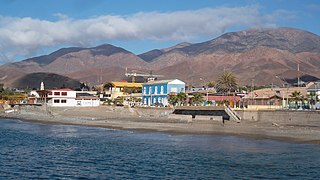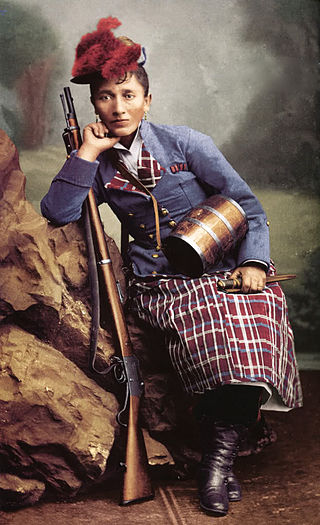
The Antofagasta Region is one of Chile's sixteen first-order administrative divisions. Being the second-largest region of Chile in area, it comprises three provinces, Antofagasta, El Loa and Tocopilla. It is bordered to the north by Tarapacá, by Atacama to the south, and to the east by Bolivia and Argentina. The region's capital is the port city of Antofagasta; another one of its important cities is Calama. The region's main economic activity is copper mining in its giant inland porphyry copper systems.

Antofagasta is a port city in northern Chile, about 1,100 kilometres (700 mi) north of Santiago. It is the capital of Antofagasta Province and Antofagasta Region. According to the 2015 census, the city has a population of 402,669.
Cerro is Spanish for "hill" or "mountain".

Antofagasta Province is one of three provinces in the northern Chilean region of Antofagasta (II). The capital is the port city of Antofagasta. Located within the Atacama Desert, it borders the El Loa and Tocopilla provinces to the north, the Pacific Ocean to the West and the Atacama Region to the south.

Estadio Regional de Antofagasta, officially Estadio Regional Bicentenario Calvo y Bascuñan de Antofagasta, is a sport facilities complex located in Antofagasta, Chile. The municipality of Antofagasta is the owner of the building and it used to host sports events such as cultural events and entertainment events. The complex is composed of the Main Stadium who is use made for most important events. The secondary fields, 1, 2, 3 and 4, are used for training sessions. The Field 5 is used to secondary events, with football pitch dimensions and counts with a Baseball field where are made the regional tournaments of this sport.

Deportes Antofagasta is a Chilean football club based in the city of Antofagasta currently playing in the Primera B Of Chile. The club's home stadium is the Estadio Bicentenario Calvo y Bascuñán, which has a capacity of 21,178.

La Portada is a natural arch on the coast of Chile, 18 km (11 mi) north of Antofagasta. It is one of fifteen natural monuments included among the protected areas of Chile.

The protected areas of Chile are areas that have natural beauty or significant historical value protected by the government of Chile. These protected areas cover over 140,000 km2 (54,054 sq mi), which is 19% of the territory of Chile. The National System of Protected Wild Areas is regulated by law #18,362 passed in 1984, and administered by the National Forest Corporation (CONAF).

Los Flamencos National Reserve is a nature reserve located in the commune of San Pedro de Atacama, Antofagasta Region of northern Chile. The reserve covers a total area of 740 square kilometres (290 sq mi) in the Central Andean dry puna ecoregion and consists of seven separate sections.

Zapaleri is a volcano whose summit is the tripoint of the borders of Argentina, Bolivia and Chile. A number of railways are in the area. It is part of Potosí Department (Bolivia), Jujuy Province (Argentina), and Antofagasta Region (Chile). The volcano formed on top of the 2.89 mya Tara Ignimbrite from the Guacha caldera and the basement beneath the volcano is formed from Cretaceous and Tertiary rocks affected by tectonic deformation. Volcanic rocks are andesite, basalt, dacite and rhyolite. Late Cretaceous rocks are also found in the area, as are Pleistocene shoshonite volcanic rocks.

The Atacama Desert is a desert plateau located on the Pacific coast of South America, in the north of Chile. Stretching over a 1,600-kilometre-long (1,000-mile) strip of land west of the Andes Mountains, it covers an area of 105,000 km2 (41,000 sq mi), which increases to 128,000 km2 (49,000 sq mi) if the barren lower slopes of the Andes are included.

Taltal is a Chilean commune and city in Antofagasta Province, Antofagasta Region. According to the 2012 census, the commune has a population of 11,132 and has an area of 20,405.1 km2 (7,878 sq mi). The commune is home to Paranal Observatory and includes the northern portion of Pan de Azúcar National Park.

The Puna de Atacama or Atacama Plateau is an arid high plateau, in the Andes of northern Chile (15%) and northwest of Argentina (85%). Geomorphologist Walther Penck based his Grossfalt landform association on Puna de Atacama.

Alto Loa National Reserve is a Protected Area located in the province of El Loa, Antofagasta region, Chile. Announced in 2002 and created in 2005, it is Chile's largest natural reserve.

China Muerta National Reserve is a national reserve in La Araucanía Region of Chile. It was created on June 28, 1968, by Supreme Decree No. 330 of the Ministry of Agriculture.

Isla Mocha National Reserve is a national reserve of Chile. It occupies the central portion of Mocha Island. It is located in Tirúa, Arauco Province, Bío Bío Region, Chile.

Irene Morales Infante was a Chilean soldier who served in the War of the Pacific. She was born in a barrio of Santiago, and lived in poverty throughout her life, working as a seamstress from an early age. When the War of the Pacific began she was only 13 years old, and had been orphaned and twice widowed. Her second husband was executed by the Bolivian military for killing a soldier.
La Chimba Airport was an airport serving Antofagasta, capital of the Antofagasta Region of Chile.
The 1991 Antofagasta mudflow was a natural disaster in the city of Antofagasta, northern Chile, that occurred on the morning of June 18, 1991. The mudflow was triggered by an unusual rainfall of 42 mm during the night. Mudflows also affected the port of Taltal 180 km south of Antofagasta. 91 persons are confirmed to have died in the disaster and the whereabouts of an additional 19 have never been clarified. About 700 houses were either destroyed or damaged beyond repairs. In Antofagasta the mudflows from the quebradas of La Cadena, Salar del Carmen, Baquedano and El Ancla were the most destructive. Other quebradas were less destructive mudflows developed were Huáscar, Jardines del Sur, Universidad de Antofagasta, Las Vertientes, Caliche, El Toro, Uribe, Riquelme, Farellones, Bonilla Norte, Bonilla Sur, Club Hípico and La Chimba.
Chimba or La Chimba may refer to:

















